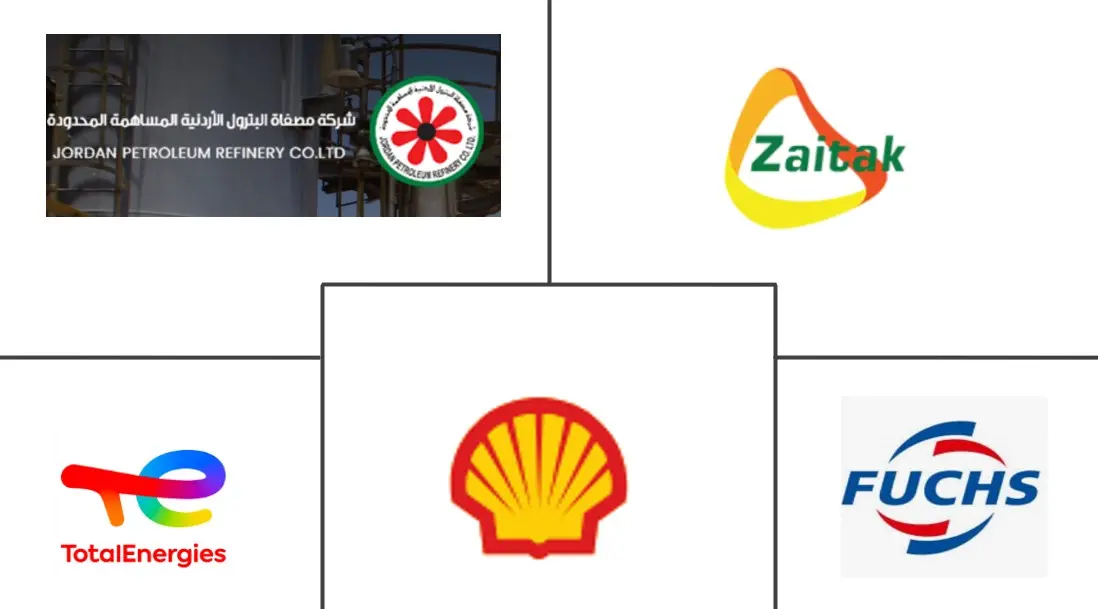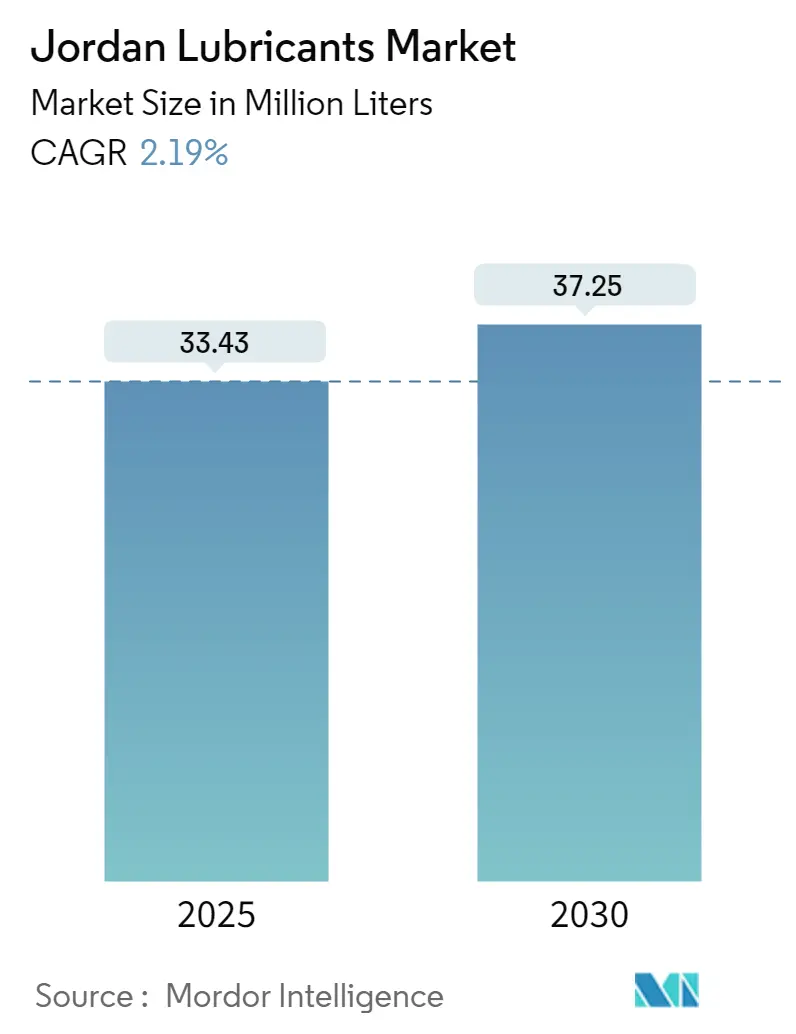
Jordan Lubricants Market Analysis by Mordor Intelligence
The Jordan Lubricants Market size is estimated at 33.43 million liters in 2025, and is expected to reach 37.25 million liters by 2030, at a CAGR of 2.19% during the forecast period (2025-2030).
- Over the short term, the surging vehicle population and robust growth of investments in the power generation sector are the major factors driving the demand in the market studied.
- However, the higher cost of lubricant products and political and economic instability in the country are likely to hinder market growth.
- Nevertheless, the growing adoption of bio-based lubricants and the development of low-viscosity lubricants are expected to create new market opportunities.
- The automotive and other transportation segment is expected to account for the largest end-user industry of the market studied while registering rapid growth over the forecast period.
Jordan Lubricants Market Trends and Insights
Engine Oil is Expected to Dominate the Market
- Engine oils, essential for lubricating internal combustion engines, typically consist of 80-85% base oils and 15% to 20% additives.
- Engine oil, a pivotal lubricant in the combustion cycle, comprises two main components: base stock and additives. Primarily, engine oils lubricate parts to mitigate friction.
- These oils are crucial for reducing wear, preventing corrosion, and ensuring easy operation of engine parts. By forming a thin film between moving parts, engine oils enhance heat transfer and reduce tension during contact.
- The light motor vehicle segment leads in engine oil consumption among all segments. Technological advancements and government mandates for fuel economy have driven automakers to produce lighter vehicles with tighter tolerances, enhancing durability.
- As the economy recovers, automotive sales are projected to see moderate growth in the coming years. This anticipated rise in automotive sales is set to fuel moderate growth in the automotive lubricant market.
- The data from the Jordan Free Zones Investors Association highlighted that in 2023, Jordan witnessed an 8.8% Y-o-Y increase in new light vehicle sales, totaling 37,587 vehicles. Furthermore, by January 2024, Jordan re-exported 3,911 vehicles, a 32% rise from 2,941 vehicles in the same timeframe the previous year. This surge underscores the Jordanian market's adaptability to global automotive industry shifts and foreign demand.
- Given the surging demand for two-wheeler and three-wheeler vehicles in Jordan, automotive firms are expanding their presence through showrooms and distribution points, boosting engine oil consumption in these segments.
- Additionally, with the private sector rebounding and OEMs like Hyundai and Toyota re-entering the market, there's a notable uptick in automotive sales and engine oil demand.
- Increasing demand for medium-duty trucks, including utility, courier, and package delivery trucks, ambulances, shuttle buses, school buses, and recreational vehicles in Jordan stimulated the market growth of lubricants.
- Moreover, strategic developments in Jordan's automotive sector further bolster the lubricants market. For instance, in June 2024, MG Motor signed a partnership in Jordan with GKS Auto, a subsidiary of the prominent GB Corp. This alliance is poised to introduce unparalleled innovation and service excellence to the Jordanian automotive landscape.
- Therefore, the factors above are expected to boost the consumption of engine oils in different sectors.
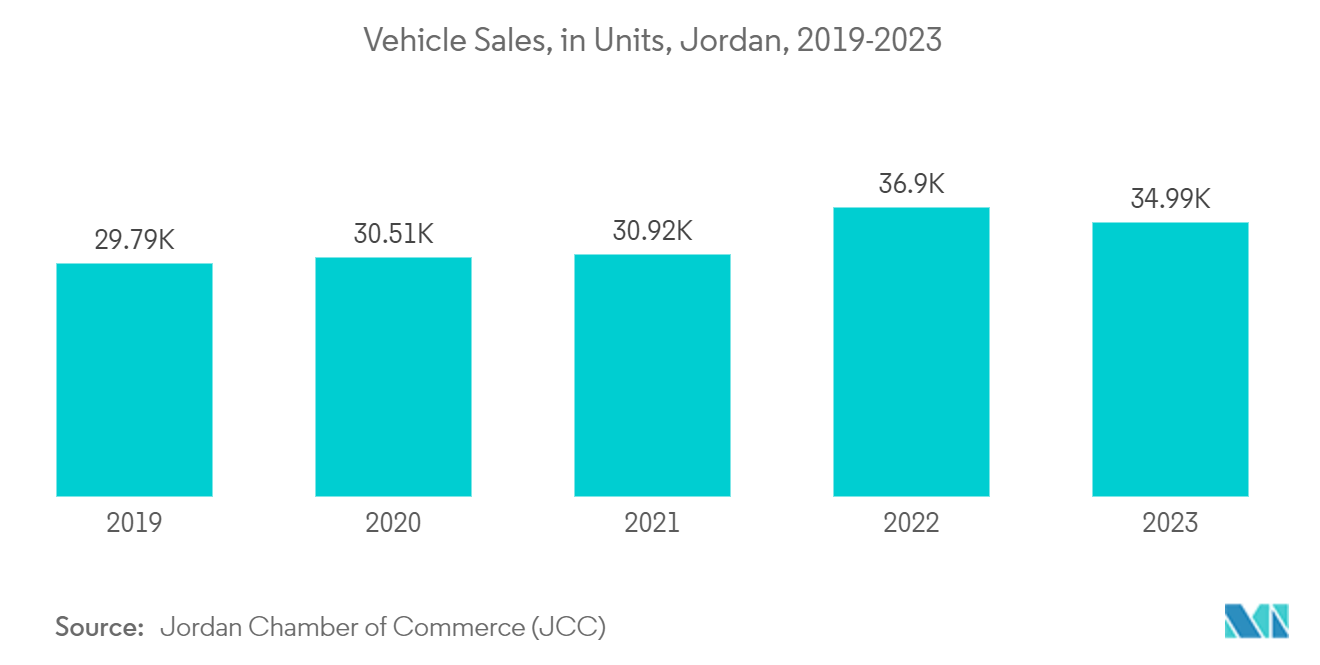
Power Generation Segment Anticipated to Experience Rapid Growth
- Lubricants are used in different power generation sectors, including wind energy, hydropower, and thermal power plants.
- Lubricants reduce friction between moving parts like bearings, gears, and turbines, preventing wear and tear and extending equipment lifespan.
- Furthermore, lubricants shield equipment from corrosion, which can arise from moisture, humidity, or chemical reactions, thereby preventing equipment failure and enhancing longevity.
- Factors such as rising electricity output driven by oil sector demands, population growth, and enhancements in generation capacity and transmission networks are influencing market dynamics.
- Additionally, the expanding power generation sector and rising energy consumption are poised to influence market growth. Nearly 94% of Jordan's electricity is generated from oil and natural gas. NEPCO (National Electric Power Company) reports a consistent rise in electricity consumption, with a notable 5.7% increase in 2022.
- As per the data from the International Renewable Energy Agency (IRENA), Jordan's solar energy capacity surged to 2.7 GW in 2023, up from 1.7 GW in 2020, marking a significant leap and aiming to lessen reliance on imported fossil fuels.
- Moreover, the first quarter of 2024 witnessed a surge in investor applications for power and renewable energy projects in Jordan, more than doubling from the previous year. As per the data from Jordan’s Energy and Minerals Regulatory Commission (EMRC), energy project license applications soared from 75 in Q1 2023 to 166 in Q1 2024.
- Given these trends, lubricant consumption in Jordan's power generation sector is poised for an uptick in the coming years.
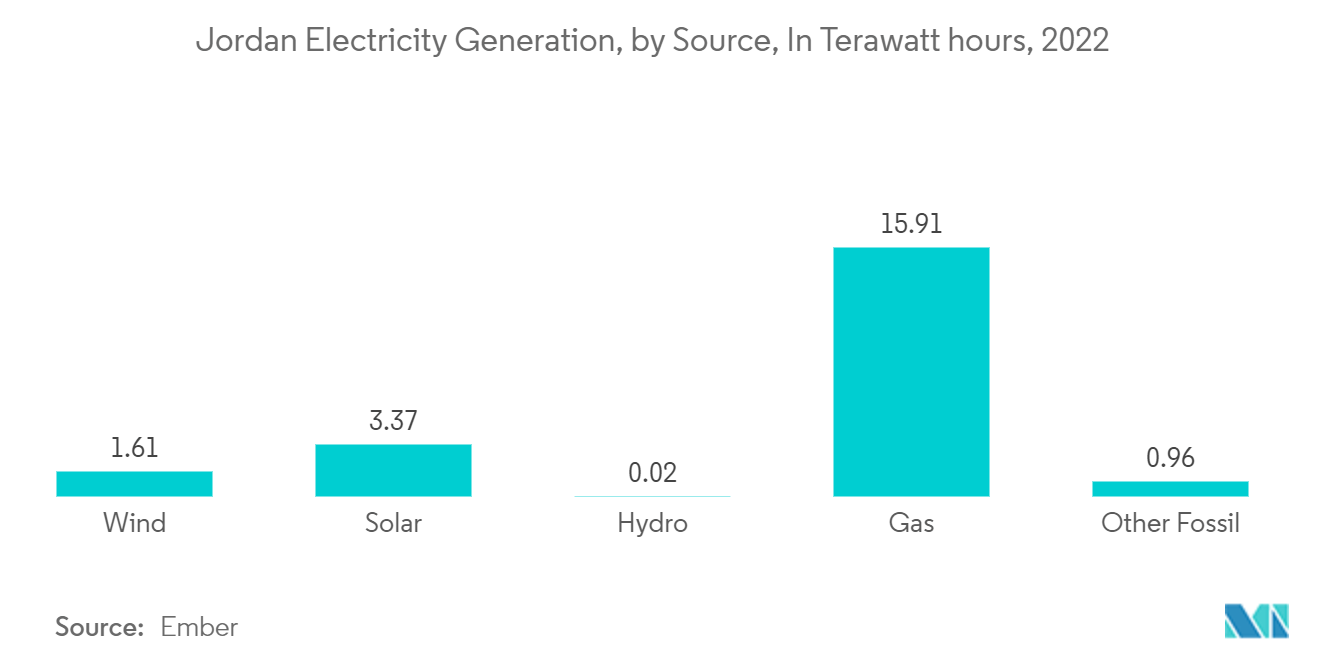
Competitive Landscape
The Jordanian lubricants market is consolidated in nature. Some of the major players in the market include Jordan Petroleum Refinery Company Limited, Jordan National Lube Oil Company LLT, FUCHS (Qais Al Rawi & Sons Company), Shell PLC, and TotalEnergies.
Jordan Lubricants Industry Leaders
-
FUCHS (Qais Al Rawi & Sons Company)
-
Jordan Petroleum Refinery Company Limited
-
Jordan National Lube Oil Company LLT
-
Shell Plc
-
TotalEnergies
- *Disclaimer: Major Players sorted in no particular order
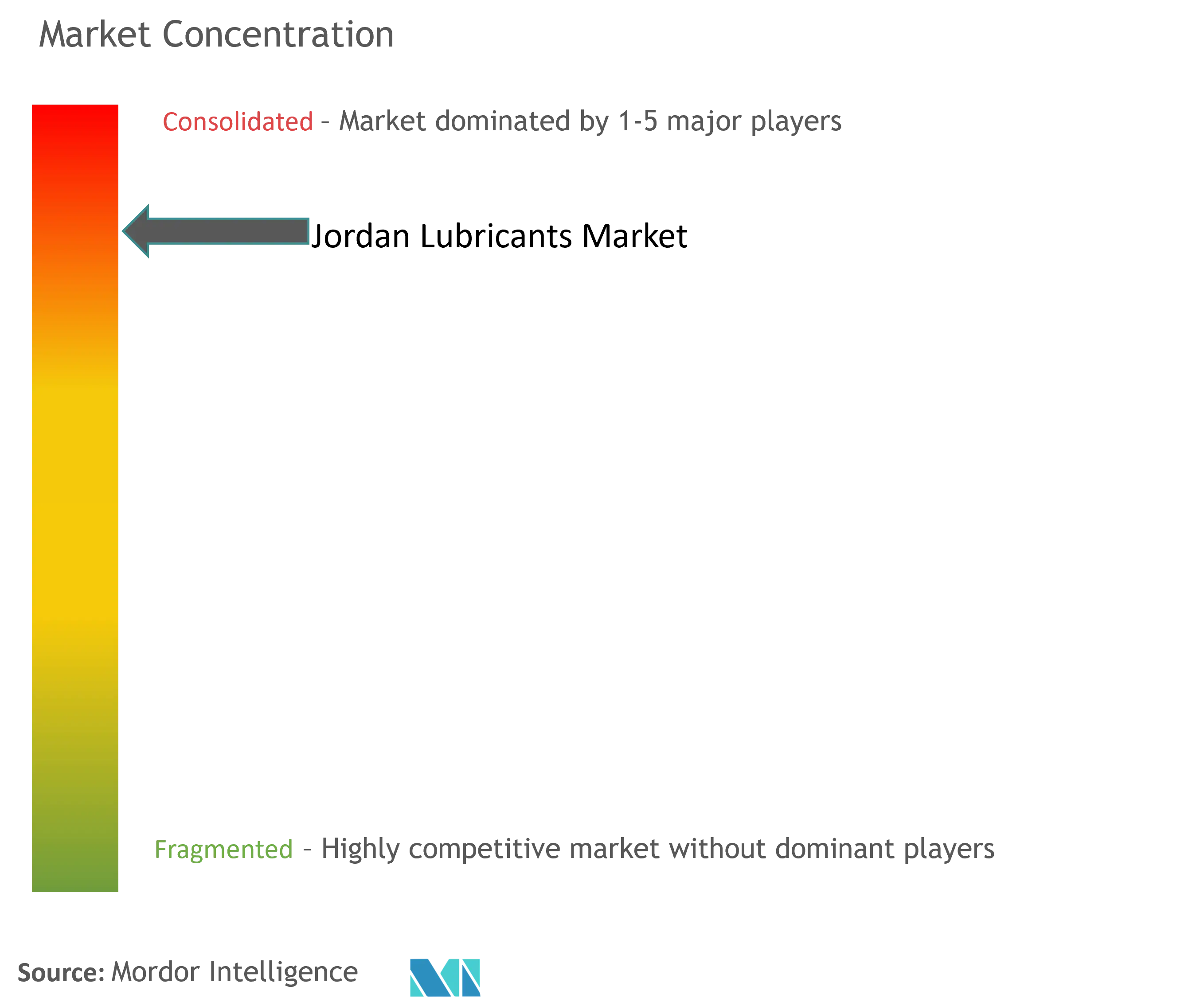
Recent Industry Developments
The recent developments pertaining to the major players in the market are being covered in the complete study.
Jordan Lubricants Market Report Scope
A lubricant is a fluidic material that reduces friction between surfaces in contact and energy loss caused by friction. It can also be handy in cleaning, cooling, and protecting metal parts from corrosion, rust, and other challenges that a vehicle, machine, or equipment faces during operation.
The Jordan lubricants market is segmented by product type and end-user industry. By product type, the market is segmented into engine oil, transmission and hydraulic fluid, general industrial oil, gear oil, grease, and other product types. By end-user industry, the market is segmented into power generation, automotive and transportation, heavy equipment, and other end-user industries. For each segment, the market sizing and forecasts were made on the basis of volume (million liters).
| Engine Oil |
| Transmission and Hydraulic Fluid |
| General Industrial Oil |
| Gear Oil |
| Grease |
| Other Product Types |
| Power Generation |
| Automotive and Transportation |
| Heavy Equipment |
| Other End-user Industries |
| By Product Type | Engine Oil |
| Transmission and Hydraulic Fluid | |
| General Industrial Oil | |
| Gear Oil | |
| Grease | |
| Other Product Types | |
| By End-user Industry | Power Generation |
| Automotive and Transportation | |
| Heavy Equipment | |
| Other End-user Industries |
Key Questions Answered in the Report
How big is the Jordan Lubricants Market?
The Jordan Lubricants Market size is expected to reach 33.43 million liters in 2025 and grow at a CAGR of 2.19% to reach 37.25 million liters by 2030.
What is the current Jordan Lubricants Market size?
In 2025, the Jordan Lubricants Market size is expected to reach 33.43 million liters.
Who are the key players in Jordan Lubricants Market?
FUCHS (Qais Al Rawi & Sons Company), Jordan Petroleum Refinery Company Limited, Jordan National Lube Oil Company LLT, Shell Plc and TotalEnergies are the major companies operating in the Jordan Lubricants Market.
What years does this Jordan Lubricants Market cover, and what was the market size in 2024?
In 2024, the Jordan Lubricants Market size was estimated at 32.70 million liters. The report covers the Jordan Lubricants Market historical market size for years: 2019, 2020, 2021, 2022, 2023 and 2024. The report also forecasts the Jordan Lubricants Market size for years: 2025, 2026, 2027, 2028, 2029 and 2030.
Page last updated on:
Jordan Lubricants Market Report
Statistics for the 2025 Jordan Lubricants market share, size and revenue growth rate, created by Mordor Intelligence™ Industry Reports. Jordan Lubricants analysis includes a market forecast outlook for 2025 to 2030 and historical overview. Get a sample of this industry analysis as a free report PDF download.
